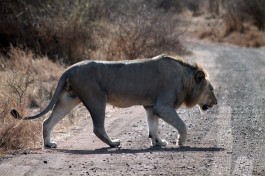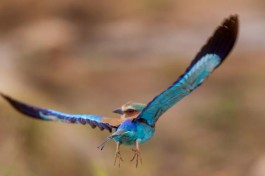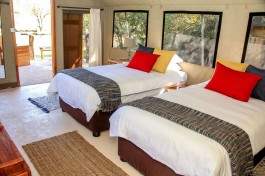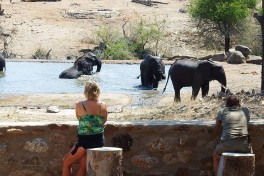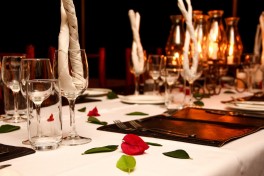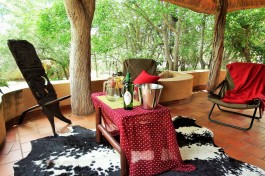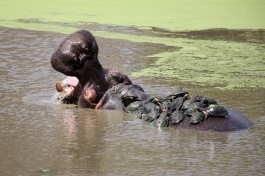5 Day Budget Lodge Safari to Maseke & Kruger National Park
Summary of this Budget Safari Package
This 5 Day Budget Lodge Safari to Maseke, Greater Kruger National Park & Kruger National Park is an opportunity to go wildlife viewing in two of the best wildlife reserves in Africa. Enjoy the intimacy of a private reserve, where you are unlikely to come across other vehicles whilst out on a wildlife viewing drive. Relish the knowledge and professionalism of your guides and trackers who will take you off road for the best sightings and photo opportunities, keeping in contact with other guides to ensure that no exciting experience is missed by any guest. Immerse yourself in the African bush at one with nature in this landscape, the silence occasionally broken by the sounds of the inhabitants.
You may wonder why this tour includes a day spent in Kruger National Park with all the benefits of staying in Greater Kruger National Park. South Africa’s national treasure, Kruger National Park is a long established national park with many interesting historical features, such as examples of rock art dating back hundreds of years, evidence of stone-age man having lived here and fascinating museums. The habitats in both parks differ and wildlife gravitates to the habitat that suits their needs, so it’s quite possible that you may spot an animal in Kruger National Park that you haven’t spotted in Greater Kruger.
This truly is a tour offering the best of both worlds, an opportunity not to be missed.
Itinerary for this Tour
Day 1: Johannesburg to Greater Kruger National Park, South Africa
This 5 Day Budget Lodge Safari to Maseke & Kruger National Park begins with an early morning pick-up in our air-conditioned minibus for the transfer to Three Bridges in Limpopo. On arrival, we are greeted by our guide from our safari camp who transfers us in an open safari vehicle for the last leg of our journey to the camp. A welcome lunch is waiting and once we have checked in we sit down to enjoy it. After lunch, there is time to familiarise ourselves with our surroundings as we wait for the afternoon to cool before we set out on our first wildlife drive.
Our specially designed safari vehicle is ideal with its elevated seats for wildlife spotting and great photo shots. It’s also designed to take us off-road and as close to any action as is safely possible. Our guide is extremely familiar with this vast area and knows exactly how best to position the vehicle for maximum viewing. Sharing open borders with the twenty private reserves in Greater Kruger National Park and Kruger National Park itself the possibility of spotting the Big 5 and all the diverse creatures that traverse this vast terrain is extremely high. We take a break from our three-hour excursion to toast the African, spectacular sunset with our sundowners and then it’s time to head back to camp as darkness falls quickly once the sun has set. With our vehicle’s spotlight turned on keep an eye out for the nocturnal creatures as they begin to wake from their daytime sleep.
Back at camp enjoy a pre-dinner drink from the cash bar and then tuck into a delicious dinner in the lantern-lit boma around the campfire.
Day 2 & 3: Greater Kruger National Park, South Africa
Awake to the sounds of African drums, your safari alarm clock, inviting you for coffee and a light breakfast, before heading out on an early morning three-hour wildlife viewing drive. The wildlife is on the move seeking out the waterholes and the best grazing before the day becomes too hot for comfort. The undulating landscapes and rocky outcrops of this vast terrain host many types of habitats with the animals making their way to the area most suited to their needs. We pause on our search to sample some tea and cake or juice and fruit – not too much as breakfast will be served back at camp.
After breakfast, it’s time to relax by the pool or watch the wildlife enjoying the waterhole at camp. There’s time for a nap in air-conditioned comfort after our early morning start. However, after breakfast on day three, our guide will offer to take us on a nature walk in the bush, noting that he is armed for our safety. Walking in the bush is an eye-opener and the guide will interpret the many signs and tracks left by animals going about their daily dramas of survival in the bush and explain how to estimate the ages and times of the sequence of events. He will also spend time birding and going into the fascinating vegetation and its traditional medicinal uses and folklore surrounding some plants. This is a not to be missed opportunity but is only available to guests of 16 years of age and older.
After our spell of relaxation, we head out into the bushveldt again ready to update our spotted list. Although days two and three follow the same format no two days in the bush are ever the same. Who knows what exciting spectacle is just around the next bend. After sundowners, we head back to camp for drinks and dinner and tales around the campfire re-living the exciting day.
Day 4: Kruger National Park, South Africa
This morning the drumbeat wakens us to the prospect of our thrilling excursion into Kruger National Park, South Africa’s treasure. Leaving camp after coffee and a light breakfast we drive a short distance to an entrance gate in the northern sector of the national park. Initially, the terrain and vegetation are similar to what we have experienced these past few days but as we head further east it begins to change. We stop en-route to Letaba to enjoy a picnic breakfast and then continue to Letaba and the fascinating Elephant Museum wildlife spotting as we journey. Our route adapts according to game movements and the seasons but we head for the Lebombo Mountains and the open plains on the foothills where there is a possibility we may see cheetah, ostrich, Kori Bustard and Tsessebe. Along the way, we stop at a rest camp for lunch at the restaurant. At dusk, we exit the national park and head back to our camp and dinner.
Day 4: Greater Kruger National Park to Johannesburg, South Africa
Sadly today we take our last early morning wildlife viewing drive in the peace and tranquillity of the bushveldt before heading back to the city. There’s time for breakfast before our guide transfers us back to Three Bridges where our minibus meets us for our transfer to Johannesburg.
About Maseke Game Reserve
Maseke Game Reserve, 9000 hectares in size, is part of the Greater Kruger National Park which is made up of privately owned game reserves. Maseke is in the northern sector of Greater Kruger Park and borders on Balule and Olifants North reserves. The terrain is undulating with prominent mountain ridges and rocky outcrops which make it an interesting area for wildlife viewing drives. The Olifants River courses through the reserve attracting wildlife to its banks. All of the private reserves in Greater Kruger share open borders with each other and with Kruger National Park, which creates a vast landscape traversed by a huge collection of wildlife, including the Big 5. Open plains attract wildebeest and zebra while elephant herds crowd forests of tall mopane trees. Rocky outcrops are home to rare klipspringer antelope, baboon troops and dassies – a magnet for leopards. All in all a diverse area which makes for an interesting, exciting safari.
About Kruger National Park
Named for Paul Kruger, it is thanks to his vision that this wildlife sanctuary was finally proclaimed as a national park in 1898. Long before tourists arrived at the park there is much archaeological evidence, which includes examples of ancient rock art, that it was home to prehistoric man, The first modern-day tourists arrived by train, as an overnight stop was included at Sabie Bridge on the train’s journey to Lourenco Marques (now Maputo). In 1926 it was finally decided to build main and secondary roads through the park, but it wasn’t until the early 30s that accommodation facilities were provided. All visitors were accompanied by a ranger and charged a fee for this service and a fee was charged for taking photographs. Since these early days, the park has progressed and today hosts millions of visitors, both local and international and is celebrated as a national treasure.
Covering an area of almost two million hectares of varied landscapes and habitats, Kruger National Park shares open borders with Greater Kruger National Park, which allows the wildlife to roam freely through this vast area. The single most remarkable thing about Kruger is the diversity of African wildlife species it hosts. Kruger is home to sizeable populations of Africa’s famous Big Five and numerous rare and endangered animals including African wild dogs, black rhinos and pangolins. The birdlife in Kruger is exceptional which includes what has become known as the ‘Big Six’ birds. These are Lappet Faced Vulture, Martial Eagle, Saddle-billed Stork, Kori Bustard, Ground Hornbill and the reclusive, seldom seen Pel’s Fishing Owl.
Perhaps the greatest threat to Kruger National Park today is poaching and measures to protect the wildlife, particularly rhino and elephant, are continually evolving.
About our Camp
Our traditional safari camp, located in Maseke Game Reserve, offers relaxed accommodation interspersed with exciting, wildlife viewing adventures. Guests are accommodated in family-friendly, 2 bedroomed thatched chalets with an interleading lounge area or in luxury, safari-style tented en-suite accommodation. The luxury tents have the advantage of overlooking the waterhole, floodlit at night, and the private patios provide an ideal spot for relaxing, beverage in hand, whilst watching the animals gather at the waterhole. The camp is fenced so it is safe for children who may get the urge to wander. As often as possible meals are served al fresco, either in the lantern-lit boma around the campfire or in the well-established garden under shady trees. There is a cash bar available for those pre-dinner drinks. The large pool, set in the lovely garden, is a perfect spot to cool off on those glorious hot summer days. Able to accommodate only a maximum of twenty guests means no overcrowding and personal attention. The experienced, professional guides offer nature walks if there is time available, noting that only guests sixteen years and older may participate. And if you can’t bear to be separated from the outside world, there is wifi available at the camp.
About Tour Transfers
Collection and drop-off will be at either the OR Tambo Bus Terminal Building or the Sasol Fuel Station in Persequor Park (Pretoria). Transport to and from these two pre-appointed locations is not included in the tour price.
Collection times on the first day:
- 06h45 OR Tambo Bus Terminal Building
Drop off times on the last day:
- 17h00 – 18h00 OR Tambo Bus Terminal Building
Image Gallery
Click the image to enlarge
![]()
